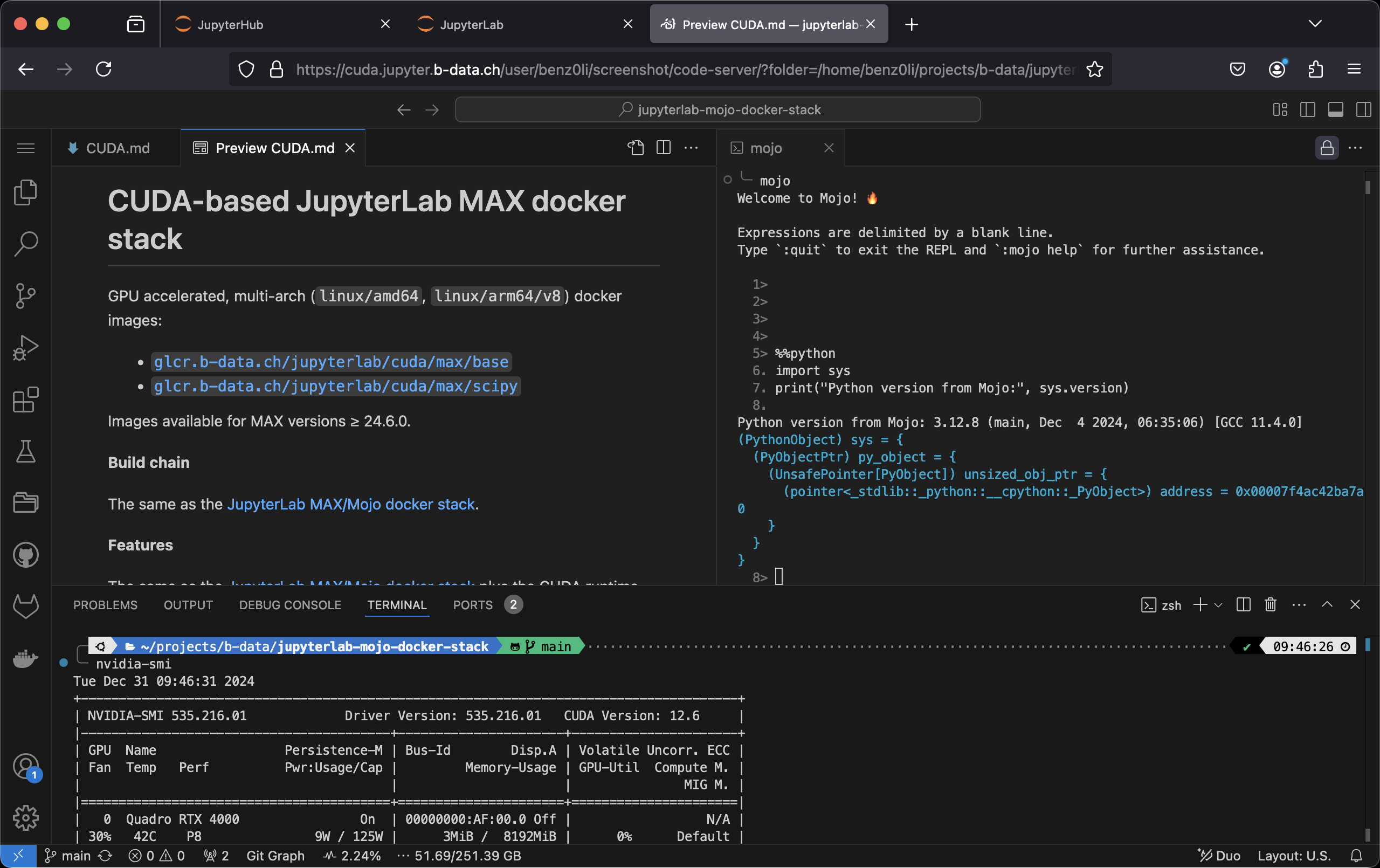-
Olivier Benz authoredOlivier Benz authored
CUDA-based JupyterLab MAX docker stack
GPU accelerated, multi-arch (linux/amd64, linux/arm64/v8) docker images:
Images available for MAX versions ≥ 24.6.0.
Build chain
The same as the JupyterLab MAX/Mojo docker stack.
Features
The same as the JupyterLab MAX/Mojo docker stack plus the CUDA runtime.
Subtags
The same as the JupyterLab MAX/Mojo docker stack.
Table of Contents
Prerequisites
The same as the JupyterLab MAX/Mojo docker stack plus
- NVIDIA GPU
- NVIDIA Linux driver
- NVIDIA Container Toolkit
Install
To install the NVIDIA Container Toolkit, follow the instructions for your platform:
Usage
Build image (base)
latest:
cd base
docker build \
--build-arg BASE_IMAGE=ubuntu \
--build-arg BASE_IMAGE_TAG=22.04 \
--build-arg BUILD_ON_IMAGE=glcr.b-data.ch/cuda/python/ver \
--build-arg MOJO_VERSION=25.1.0 \
--build-arg PYTHON_VERSION=3.12.9 \
--build-arg CUDA_IMAGE_FLAVOR=base \
--build-arg INSTALL_MAX=1 \
-t jupyterlab/cuda/max/base \
-f latest.Dockerfile .version:
cd base
docker build \
--build-arg BASE_IMAGE=ubuntu \
--build-arg BASE_IMAGE_TAG=22.04 \
--build-arg BUILD_ON_IMAGE=glcr.b-data.ch/cuda/python/ver \
--build-arg CUDA_IMAGE_FLAVOR=base \
--build-arg INSTALL_MAX=1 \
-t jupyterlab/cuda/max/base:MAJOR.MINOR.PATCH \
-f MAJOR.MINOR.PATCH.Dockerfile .For MAJOR.MINOR.PATCH ≥ 24.6.0.
Create home directory
Create an empty directory using docker:
docker run --rm \
-v "${PWD}/jupyterlab-jovyan":/dummy \
alpine chown 1000:100 /dummyIt will be bind mounted as the JupyterLab user's home directory and automatically populated.
Run container
self built:
docker run -it --rm \
--gpus '"device=all"' \
-p 8888:8888 \
-u root \
-v "${PWD}/jupyterlab-jovyan":/home/jovyan \
-e NB_UID=$(id -u) \
-e NB_GID=$(id -g) \
jupyterlab/cuda/max/base[:MAJOR.MINOR.PATCH]from the project's GitLab Container Registries:
docker run -it --rm \
--gpus '"device=all"' \
-p 8888:8888 \
-u root \
-v "${PWD}/jupyterlab-jovyan":/home/jovyan \
-e NB_UID=$(id -u) \
-e NB_GID=$(id -g) \
IMAGE[:MAJOR[.MINOR[.PATCH]]]IMAGE being one of
The use of the -v flag in the command mounts the empty directory on the host
(${PWD}/jupyterlab-jovyan in the command) as /home/jovyan in the container.
-e NB_UID=$(id -u) -e NB_GID=$(id -g) instructs the startup script to switch
the user ID and the primary group ID of ${NB_USER} to the user and group ID of
the one executing the command.
The server logs appear in the terminal.
Using Podman (rootless mode)
Create an empty home directory:
mkdir "${PWD}/jupyterlab-root"Use the following command to run the container as root:
podman run -it --rm \
--device 'nvidia.com/gpu=all' \
-p 8888:8888 \
-u root \
-v "${PWD}/jupyterlab-root":/home/root \
-e NB_USER=root \
-e NB_UID=0 \
-e NB_GID=0 \
-e NOTEBOOK_ARGS="--allow-root" \
IMAGE[:MAJOR[.MINOR[.PATCH]]]Using Docker Desktop
Creating a home directory might not be required. Also
docker run -it --rm \
--gpus '"device=all"' \
-p 8888:8888 \
-v "${PWD}/jupyterlab-jovyan":/home/jovyan \
IMAGE[:MAJOR[.MINOR[.PATCH]]]might be sufficient.
Similar project
What makes this project different:
- Derived from
nvidia/cuda:12.8.0-base-ubuntu22.04 - IDE: code-server next to JupyterLab
- Just Python – no Conda / Mamba
The CUDA-based JupyterLab MAX docker stack is derived from the CUDA-based Python
docker stack.
